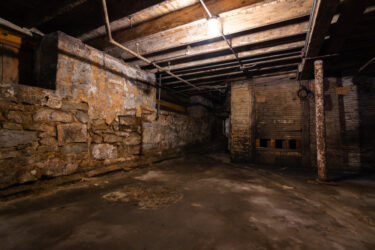5 of the Most Common Basement Problems & How to Prevent Them
 Think of the last good scary movie you’ve seen, and more likely than not it included a scene staged in a creepy basement somewhere. What is it about basements that often brand them as ominous?
Think of the last good scary movie you’ve seen, and more likely than not it included a scene staged in a creepy basement somewhere. What is it about basements that often brand them as ominous?
A finished basement serves greatly to dispel that stereotype, as ideally, it is a seamless extension of your home. However, because basements are completely or partially below-grade level, they have unique issues that need to be addressed, mainly associated with water and moisture. Keep your basement from becoming the set for the next hit thriller by preventing the following five horror stories.
1. Humidity and mold
Moisture in the air can cause condensation on surfaces. This leads to mold, corrosion, and other forms of rot. Fix any leaks. Make sure the gutters on the exterior of your home are clean and of the right length to properly carry water away from your home’s foundation.
2. Bad smells
Don’t just assume that “all basements smell weird.” A foul basement odor is most often another sign of water collecting somewhere in the basement. Check all surfaces that are wood, drywall, fiberglass, leather, cloth, or painted for signs of dampness or moisture. Be sure to check the crawl space, too, as water from the outside can sometimes leak into it and form puddles.
3. Cracks and leaks
Whether in the windows or foundation, cracks allow water to slowly seep into the basement, and can eventually cause structural damage to your home. Regularly check for cracks in windows and concrete surfaces, and repair as needed. The best way to stop leaks is to repair the cracks before they become large. If cracks in your home’s foundation continue to appear and spread, a professional basement contractor or structural engineer should be consulted to assess the structural integrity of the home.
4. Unstable foundation
As basements in all but the oldest of homes are poured in concrete, forming the home’s foundation, they are key to the structural integrity of the house. Any issue with with foundation, such as excessive cracks, can make the basement’s wall’s susceptible to settling and shifting. While some settling of a home is inevitable, significant cracks in basement walls can be symptomatic of unstable foundations.
5. Outdated design
Just as fashion styles come and go, so do architectural and home furnishing trends ebb and flow–though, thankfully, not as quickly! It’s easy to get caught up in decorating the main level of your home and forget entirely about the basement. Don’t let your basement become drab and dreary! Perhaps it’s as easy at adding a few new colorful throw pillows and a bright piece of art. On the other hand, maybe it’s time to consider a more major remodel and create the space you’ve always dreamed of that will quickly become the favorite gathering spot in your home. Either way, reclaim your space and help give basements the reputation they deserve!

